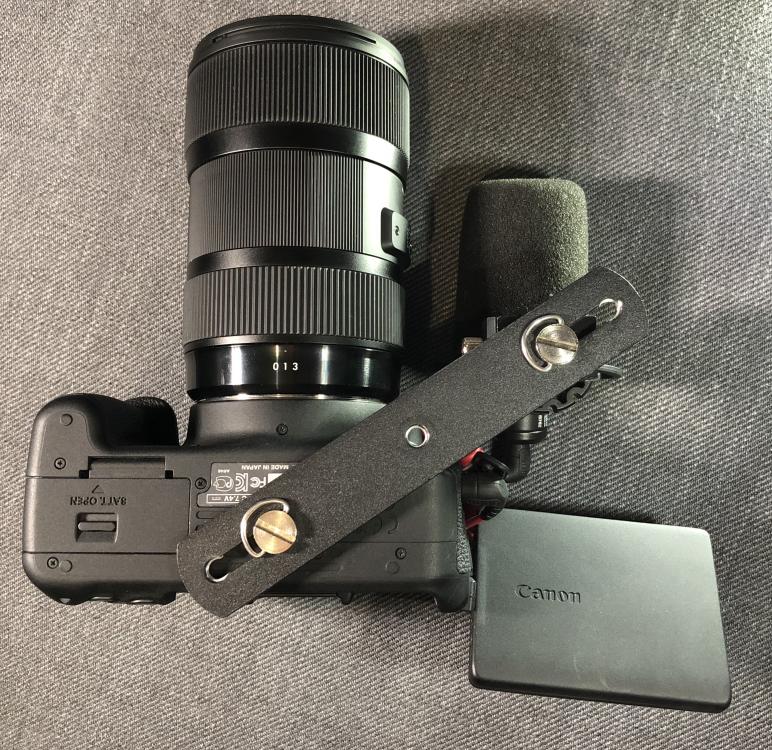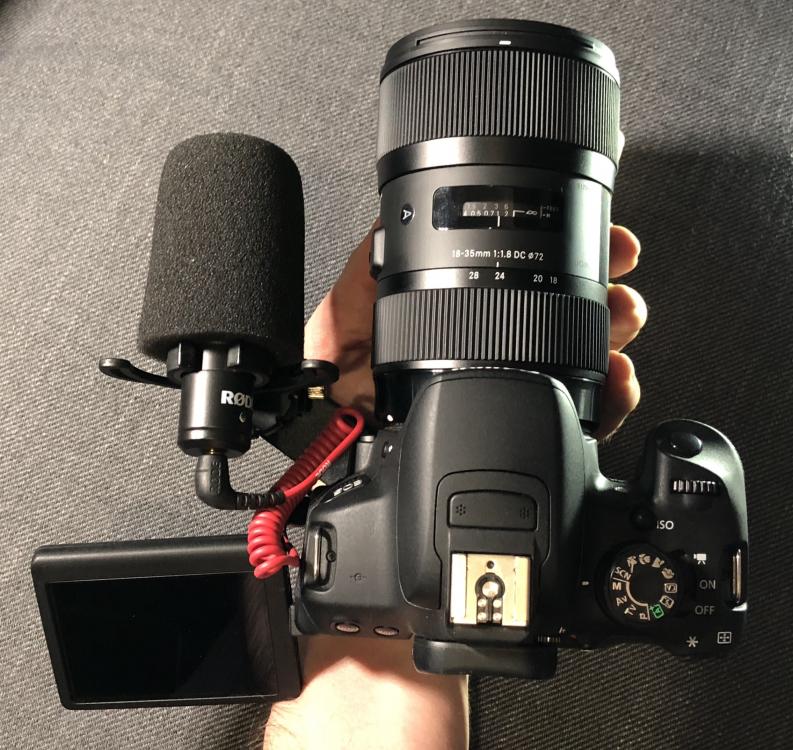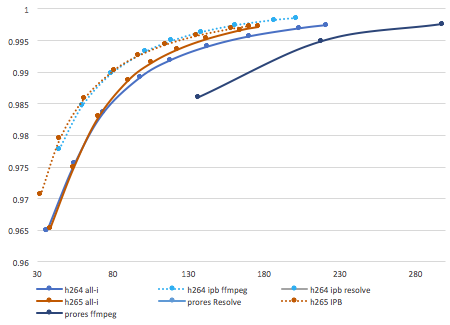-
Posts
7,835 -
Joined
-
Last visited
Content Type
Profiles
Forums
Articles
Everything posted by kye
-
How on earth would that happen??? WTF are people doing with their SD cards.... wow.
-
It sounds like this is your workflow: Shoot and record in either 4K Prores RAW or 4K Prores 422 or 4K 420 Edit / grade and export to 4K h264 Upload to YT If so, I suggest you consider the bitrates involved. 4K YT is something like 30Mbps. People suggest that you want to upload around 100-200Mbps h264 to YT to get the best results, but that any more than that is just wasting bandwidth. So shooting 4K Prores 422 would mean shooting 471Mbps to export in 100-200Mbps for YT to stream in 30Mbps. In this sense there's a pretty limited return on investment for shooting a higher quality acquisition format. The other consideration is that 8-bit and LOG formats aren't a good combination, so I'd suggest you either shoot 10-bit 422 and LOG, or shoot 8-bit and a more rec709 profile. Here's a reference for codecs and bitrates / bit depths / etc: https://blog.frame.io/2017/02/13/50-intermediate-codecs-compared/ and here's the thread where the YT quality and bitrates was tested: https://forum.blackmagicdesign.com/viewtopic.php?f=21&t=85016
-
That lens looks familiar.... I think I paid $20 for it, including shipping.
-
Welcome to the forums.. no need to lurk for so long, most of us don't bite 🙂 Reframing in post is one of the (few) valid reasons for "needing" 4K, and grabbing stills for PR isn't a bad application either. I've been editing 4K footage on a 2016 MBP 13inch which is only a dual-core, so not particularly powerful. It does well if you render proxies, but the online/offline workflow is a bit of a PITA. Another thing to consider if you're filming yourself is to get multiple cheaper cameras and have more than one angle recording at once. You already have several lenses, so with a dumb EF-MFT adapter you could easily get a second angle for little extra cost.
-
@Anaconda_ @newfoundmass YT is pretty much a brick wall when it comes to quality. You can give it higher quality files, but the quality bump is almost negligible. I haven't done exhaustive testing because it's been covered pretty well in this thread (look for the posts by Bryan Worsley): https://forum.blackmagicdesign.com/viewtopic.php?f=21&t=85016
-
The plot thickens.... YT delays the audio by an additional amount, and at the lower resolutions delays the audio by more. Turns out that due to YT delay, the video above from John was actually one frame ahead of the beat and TWO frames ahead of the beat. John has this followup, which includes an adjusted comparison, and I think there's much more of a difference now:
-
Sounds like you're at the start of your journey. A few thoughts that hopefully will be of use: Think very clearly about why you want 4K. If you want better image quality than your Canon Rebel then 1080 would do that. Your Canon Rebel outputs 1080p files, but they are absolutely terrible quality compared to almost any other camera that shoots 1080. You would be amazed. Long story short, I have been where you are now. I had a Canon 700D, and noticed that the video wasn't "sharp". I thought I needed 4K. I spent thousands of dollars on a Canon 4K cinema camera (the Canon XC10), 4K display, new computer to handle 4K. After shooting with the XC10 for about a year I realised that it didn't have the type of image I was looking for. I also learned that the 4K it shot was actually a lot worse than many other cameras 1080p footage. This is because the XC10 had 4K and a high bit-rate, but these things aren't the only things that matter. I moved to a GH5 and I am now shooting with that and really happy with the images. The GH5 can shoot great quality 4K - it is still right up there with the latest cameras. But here's the thing, i'm now going back to 1080p. The quality of the 1080p image from the GH5 is just as good as the 4K modes in most situations, the file sizes are better, and the workflow in post is much easier to deal with. There is no "best" camera. Every camera is a compromise, and a very serious one at that. A few radical examples - my GH5 is better than the $100K Alexa LF they shoot Hollywood blockbusters on because my GH5 has image stabilisation and the Alexa doesn't. That stabilisation is critical in the work I do and how I shoot. I say this as a prelude to the next point.... Cameras are all very different and the "best" camera is the one that will suit you. The P4K has a great image and files are nice to edit in post, but file sizes are huge, battery life is abysmal, it doesn't have stabilisation so you need a rig of some kind. In these ways the Olympus is completely different, the image is good but not as good, files are smaller but are much more difficult to edit in post, battery life is probably fine (I can't recall), and it has stabilisation. The first step in choosing a camera is working out what and how you shoot, then finding the best camera for you. If you're a chef you can buy the best fork in the world but it's still going to be completely useless for eating soup! I just use a USB card reader from Transcend. I've found that card readers can be absolutely rubbish, but the Transcend USB 3.0 one is cheap and the data rates are huge, much faster than the high-speed cards I have. 4K is a serious serious headache that you should seriously reconsider before you start down this path. Compared to 1080p, 4K has 4 times the number of pixels, which means everything in your entire setup needs to have 4 times the performance. A suggestion that you should consider is buying a cheap 1080p camera (such as a GH3) and using it to work out what you really need. It would be a very small cost investment, combine it with a Metabones SB and you could use the lenses you have but it would give you the opportunity to shoot a bunch of projects on it, edit them, learn the workflow, learn the pros and cons, and then once you've really got an understanding then you can sell it (probably for as much as it cost you) and then upgrade with much more confidence. Here's what a cheap but good 1080p camera (the GH3) looks like:
-
I quoted you here from the other thread (to keep things tidy and on-topic) to ask you about using the "slow" setting you mention above. I tried a slow encode in one of my above tests and found it to have an insignificant difference in IQ compared to the normal setting. Have you compared the two settings directly? I do recall the "slow" setting was dramatically slower though!
-
I've been doing various tests of image quality (Prores vs h264/h265) and also YouTube quality, and i'm thinking my next test will be if YT at 4K is good enough quality to tell the difference between a 4K acquisition / 4K upload and a 2K acquisition / 4K upscaled upload. The reason I mention this is that you're wondering if 4K 420 8-bit would be "good enough" for YT, whereas I think there's a chance that even 2K 422 might be "better" than 4K YT. My experience is that the difference between a great 4K master and a barely passable 4K master is basically invisible once YT compression has done its thing and brutally crunched the image.
-
-
You might be looking for a "flash bracket" - something that you can mount to the camera using the tripod screw underneath, and will provide other mount points for various things. They come in all shapes and sizes. Here's the BH page for some ideas and photos, but they're all over ebay and other stores. https://www.bhphotovideo.com/c/buy/Flash-Brackets/ci/653/N/4168864826 I've got a few different designs, some are aluminium, some steel, some good some cheaper, etc. You can combine various ones together, to make whatever you like really.
-
Not a stupid question at all, and I use a micro SD card in my GH5 via an adapter and it records just fine. I'm recording 4K at 150Mbps or FHD at 200Mbps with it and an adapter. The cards I have aren't UHS-II so I can't do the 400Mbps modes continuously, but they're just fine. I tested a high speed micro SD card in various SD adapters once via a speedtest and all the adapters worked just fine and all got the very high speeds that the card was rated at. What camera are you using?
-
There's a saying in business - "100% of nothing is still nothing". It's typically used to comment when people who own a business stifle the growth of the business because they want to retain full ownership and control and aren't willing to accept investment from other people. I bring it up because I fully agree with @IronFilm about how people perceive battery choices on new products. It is something that sways people's opinions, and you get more profit from having lots more customers with only a small hit to profit margins. Think of how many times you've seen a review of a monitor or a battery powered LED light and how the reviewer is happy to tell you that something takes "Sony NPF" or "Canon" batteries - they light up because it's something that could be a major pain but isn't. The comments are normally along the lines of "and we've all got a bunch of them already so we're sorted". Think about how the P4K took Canon LP-E6 batteries. They lasted 30 minutes a pop, and (here in Australia anyway) were about $100 each for the genuine ones. Want to have a small rig but be able to shoot all day? Let's imagine you'd need 10 of them. That's AU$1000. Plus chargers. That's a pretty significant percentage of the cost of the camera. Batteries are not a small cost, and worse still, it's got that hassle factor. People resent having to spend hundreds of dollars on batteries. It matters.
-
With all my codec comparing and YT quality measuring, I'm interested to know how people are actually delivering their content? I've made it multiple choice so you can select more than one option, so if it varies a little then put perhaps the two or three most common methods you use.
-
I've played around with timing quite a bit and found that I prefer to cut on a balance of the on-beat and off-beat and also in-between. I used to write electronic music, and found the timing to be a very similar exercise - you want variation in timing, you can push ahead of the beat to drive things forwards, behind to slow them down, at various "off" beat points to surprise and be more whimsical or jittery - the combinations are endless. It's kind of syncopation in the timing. An edit on a softer beat of the music can create a less emphasised edit, the opposite of an edit on a big hit.. In a sense I kind of hear/feel the edit points, maybe that's because I'm used to music instead of visual mediums. This might be interesting:
-
Brandon Li with a short film shot on A7s3, plus his impressions and some zoomed in examples of noise, IQ, and AF tracking etc. Quite a useful video it seems:
-
Just watched this and thought it was really interesting - I haven't seen this mentioned before anywhere. I've played with editing to music and was never sure if I should put an edit on the nearest frame before or after the beat, but never thought about moving the edit point deliberately away from the audio queue. It was an interesting aesthetic, even through YT compression. What did you see?
-
TLDW; he didn't cancel but ended it on a cliffhanger. He did talk about being productive instead of focusing on equipment though.
-

Canon EOS R5 overheated in my fridge! After just 60 JPEGs! (4 °C ambient)
kye replied to Andrew Reid's topic in Cameras
Or making sure they never acknowledge that he was right so that in the 'official' narrative he continues to have a question-mark next to his name in the eyes of consumers regarding his track record. If Canon never acknowledge it then the memories of the event may well be reduced to: What happened to that R5 overheating thing? I don't know - that guy was making all sorts of accusations, something about it overheated in his fridge? Was it real? Did Canon actually stuff it up? They never said anything, and cameras were hard to get at the start, so maybe Was it a faulty unit? Maybe, but I never heard anything about a recall except some talk about something secret I searched the other day and I just got internet people talking, so who knows. And cameras like that ALWAYS have supply problems at the start It must be because EVERYONE wanted one Yeah - it is a great camera - 8K RAW is amazing People must have been beating at Canons door! HAHA, all the VIPs wanted to skip the queue! THE R5 IS AWESOME!! CANON IS AWESOME!!! CANON FOREVER!!!!!!! If they acknowledge it, that narrative gets changed in a lot of people's heads. -
It's time to stop fetishising Prores - h264 422 10-bit ALL-I and h265 422 10-bit ALL-I codecs are better than Prores at the same bitrate, and h265 doesn't have much advantage over h264 either, so you're better off with h264 because it's very friendly in post and shouldn't require transcoding. Vertical axis is better IQ, and horizontal axis is bitrate - read more here: Anyone who has ever watched their AF system focus on the wrong thing should know that AF isn't about how many dual pixels you have, when they're focusing on the wrong thing then your shot is still ruined. I switched to manual focus and have never looked back. Currently my GH5 is still kicking all these cameras asses, because of the firmware updates it got and these camera MIGHT get. You're all jumping at shadows - until these cameras either do (or don't) get higher bitrate ALL-I codecs then it's all conjecture. Panasonic have hinted very strongly that a GH camera is coming, and wether this is true or not doesn't really matter - some or all of these cameras will get firmware updates to hugely upgrade them, and if they don't then it will be because there's another camera that will come in and take a place higher up in the lineup. Chill and let the dust settle. Or, more likely, wait until all the options have even been put on the table, then let the dust settle, even just a little....
-
Another Komodo impressions video with some sample footage and some criticisms (plus an R5 joke!):
-
True, but with the caveat that it's comparing Prores with h264 221Mbps 10-bit 422 ALL-I. Not many cameras can shoot that, even in FHD!
-
Absolutely spectacular!
-
Yes. I got the second edition. I made it up to p95 yesterday, skipping a lot of things that weren't relevant or I already knew. It's a case of some things stay the same and other things change fast... The section talking about codecs was talking about using Prores and DNxHD and how consumer formats are to be avoided if possible. But then it talks about h264 and mentions how it's typically 48-72Mbps and 420 8-bit, so obviously that's not the case anymore. There's a side section about rec2020 (which is the colour space for HDR) and how there are jokes that displays that can display rec2020 won't be available until 2020! It then has a note saying that if you're reading the book from the future then to be kind about their horrendous optimisim / pessimism (depending on what actually happened). On the other hand, techniques for getting the right contrast or using colour wheels to adjust tint in shadows/mids/highlights hasn't changed and may never change.
-
Be careful with this - the EF mount has more flange distance than the FD mount and converting can mean that the adapted lens doesn't fit on some speed boosters. This was from the recent video by Media Division:







